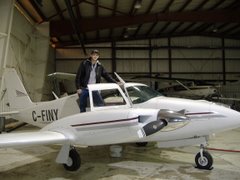I've gone over almost the entire map now, and recorded in a spreadsheet the names of the towns and the line # that runs over top of them. Every flight line in our grid is numbered, and the company geophysicist, who processes our data keeps a spreadsheet list of each numbered line, and how long it is. So after obtaining that, I've written a VBA (Visual Basic for Applications) excel program, and now I can specify the line # we're going to start our flight on, and the time we're going to begin surveying, and my VBA program will chew through my database of communities and the geophysicist's spreadsheet of survey lines, and spit out a list of each town we'll be overflying for that particular flight, and the start and end time of each line we fly. I send that list over to the Captain, and he sends out faxes to each community with the calculated time we'll be flying overhead. Done and done.
Now I don't have to spend hours pouring over the map calculating what towns and when we'll be flying over them. It just takes 10 seconds to get the program to spit me out a list, and if we change our flight plan I've only wasted 10 seconds and not an hour. Its also useful to find out how many lines and line kms we can expect to fly for the day. Its always fun when a hobby like computer programming becomes useful.




Hi Chad. Thanks for the post. That sounds frighteningly like work. It also sounds very exact. Is there a range of times in the notifications you send to the locals, or is it "We'll be here at 12:02 am. Set your watches when we pass over?" Also, what happens with all of that timing if you have to refly a line?
ReplyDeleteWayne - Those are all very good questions, ones that I wish I could answer! The wording in our permits seem to indicate the need for exact times, so that's what my computer program spits out. The reality of what actually happens in the air is much less precise of course, lol.
ReplyDeleteWe get the sense that the air authority doesn't actually expect us to be exactly within our stated time to the minute, just more or less roughly when we'll be over so if they get complaints they'll know its us, so in the air we just go with the flow. We're still trying to figure it out ourselves...
Bravo Chad! You're genious!
ReplyDelete